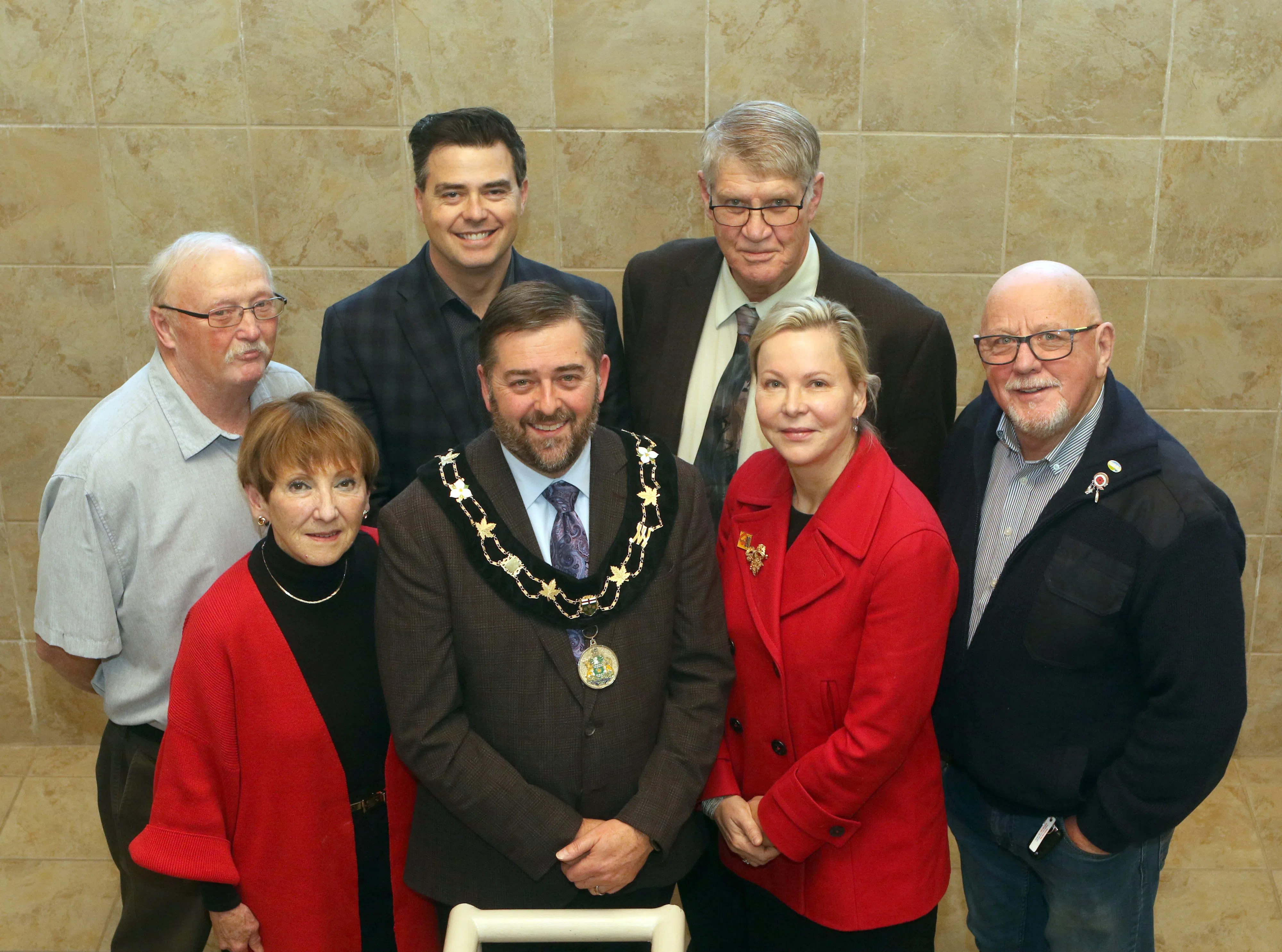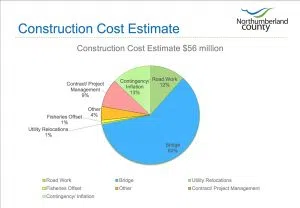socastcmsRssStartOldies 100.9 News staffsocastcmsRssEnd

While concerns remain around soaring projects costs and how to fund potentially up to $56 million for the Trent River Crossing (Campbellford Bridge) and arterial road network project, Northumberland County council has backed a “last resort” bylaw to approve expropriation of lands that officials say are needed to facilitate construction.
At council’s Wednesday, Sept. 17 meeting, staff delivered a project update – which was received for information only as this point – and then approved the bylaw to advance further property acquisitions following a series of in-camera sessions.
For more than two decades, planning and design work on the Trent River Crossing project has been in the works.
“It really is more than just a regular bridge infrastructure project,” explained director of public works Denise Marshall, who walked council through the latest Wednesday.
According to staff, this project is described as a “transformational infrastructure project” aimed at enhancing accessibility and connectivity of the regional transportation network and beyond, while also supporting economic growth and improving quality-of-life and safety for residents.
What’s more, as Campbellford moves forward with plans for a new hospital, the second bridge – which would link Alma and Second streets – is described as a “critical link, ensuring reliable access for patients, health-care workers and emergency services.”
The project – which remains in the 90 per cent detailed design stage – has also proposed extensive improvements to the surrounding road network to enhance traffic flow and safety, support businesses, tourism and regional mobility – and beyond alleviating congestion, it will help extend the lifespan of the aging bridge in Campbellford (built in 1968 and in need of major rehabilitation), which is currently the only bridge in the community. This new development would also ensure a “suitable detour route” is in place when that work gets underway.
Marshall also highlighted the project is anticipated to have a $72-million economic impact, as well as translate to a 10 per cent hike in tourism receipts in Northumberland. Further metrics and data collected indicate $6,680 in daily savings in commercial and personal travel efficiency are probable, in addition to $1.67M in annual savings across working days and 240 to 400 direct- and in-direct jobs during construction.
But none of this is said to be possible without the county acquiring 21 privately-owned properties.
Following earlier council direction, Marshall said staff started work on property acquisitions in late 2024.
“We have in parallel initiated the expropriation process through council’s direction, and this is in parallel with the voluntary negotiations.”
Some of the homes acquired will be reused or resold, while others are slated for demolition.
In response to MBC follow-up inquiries around how approaches may change following the bylaw passing, director of communications and IT Kate Campbell echoed that the county’s goal remains to acquire the necessary property for the Trent River Crossing “through fair and voluntary negotiations.”
“However, because expropriation is a lengthy legal process, the county has initiated the formal steps required under the ‘Expropriations Act’ as a precaution,” added Campbell. “This does not mean properties will automatically be expropriated – this is a last resort to ensure the county will still have the ability to secure necessary lands in time for construction.
“Property owners have been notified, and negotiations continue in good faith to achieve mutually-acceptable agreements.”
In a staff report, it states in April 2023, when council received an update at the 60 per cent design stage, staff were authorized to initiate the process to acquire properties to construct the bridge and surrounding road network in May 2023. Then, further council direction, the report states, followed on property acquisition in November 2024 and January 2025. Further, a notice of application for approval to expropriate land was also supposed to be served to affected property owners in April.
Currently, the project still needs to get the 100 per cent design stage, finalize tender documents and obtain all agency-related approvals and permits (of which there are several agencies involved), with a goal of tendering the project in early 2026. (Some agencies involved range from Parks Canada to Transport Canada, to Fisheries and Oceans Canada, Lower Trent, and the Ministry of the Environment, Conservations and Parks.)
Should this all fall into place – and subject to further council direction and funding – construction could then start next spring and extend into fall 2028. A peer review of the design is also underway now.
POTENTIAL $40M-PLUS FUNDING GAP
However, funding remains a major concern, as estimated project costs have now soared to nearly $56M.
According to staff, there are several factors for the increases. The 2025 construction cost estimate has increased significantly from previous cost estimates in 2016 and 2023, reported staff, adding that based on just non-residential construction inflation indexes, the impact of inflation alone accounts for a $12.6M hike in comparison to the 2016 estimate.
Another example provided for the proposed 188-metre bridge itself points to inflationary pressures around materials such as steel and concrete, translating to $14M (the bridge alone accounts for 60 per cent of the related budget and roadwork another 12 per cent.)

Additionally, staff said during the detailed design, the need for increased quantities/materials was discovered. Other items such as contract administration and inspections, bonds, insurance and security, contingencies, and other factors were also not initially accounted for, noted staff.
The latest estimate is supposed to be inclusive of hard construction costs, project management costs, inflationary pressures and contingencies.
On Wednesday, council heard a Municipal Housing Infrastructure Program – Housing-Enabling Core Servicing grant to tune of $26M was unsuccessful. However, following an AMO presentation, Northumberland has been encouraged to apply through a possible second fall intake, noted Marshall.
What’s more, staff are still waiting to hear back on a possible Active Transportation Fund federal grant for $11.4M.
Director of finance/treasurer Matthew Nitsch said this project is included in the county’s development charges study as being 75 per cent recoverable through development charges, translating to about $42M for the project that should be covered this way.
“The issue with that is we have not and will not have collected $42M from development charges in order to be able to pay those bills. We’ve had this issue with smaller projects – and it hasn’t been an issue because we have enough cash on hand but with a project of this size, we run into this cash flow issue.”
In other words, this means in the short-term, the county still needs to pay invoices and fund this from a non-development-charges source, which most likely means a loan, explained Nitsch.
Nitsch noted about $3.5M in development charges for transportation is currently accessible and can be used. Another $2M over the next two years would mean $5.5M for the project.
There’s also money set aside in reserves – mostly through the dedicated infrastructure levy, which sits at $6M and just under $2M being set aside annually that could lead to $10M in reserves that could be used, he added.
“Obviously, a grant would be an ideal scenario for funding, but failing that, if we’re not successful for the $11.4M – or any other grant funding – then we would be left with $40.5M that we would need to somehow pay for.”
Referencing current rates through an Infrastructure Ontario loan on $40.5M, that would translate to $2.8M payments annually. If the $11M grant came through and only $29M was needed, this means about $2M yearly payments on a 25-year loan, explained Nitsch.
Simply put, Nitsch said the issue to be mindful of is debt limits, specifically internal debt limits set by council. While the limit can be changed, the question remains how much debt is Northumberland comfortable with?
Meanwhile, there are other projects on the go – including housing developments – and with all this in mind, it could mean reduced flexibility for other projects and this will have to be a key consideration, explained Nitsch, who also touched on additional debt taken on in 2024 around the Golden Plough Lodge and Elgin Phase 2 developments.
While it was noted that development charges can still help pay down debt after the project starts, there are a range of possibilities that could unfold – it could take decades, or a significant development in the area may translate to a substantial increase, as just two examples.
For Deputy Warden – and Port Hope Mayor Olena Hankivsky – she was “spinning” after hearing the latest figures Wednesday.
“I’m just having sticker shock – that’s my initial response to this …” she said, while adding she’s still trying to reconcile with the recent overages related to the GPL redevelopment.
Coun. Lucas Cleveland – who serves as Cobourg’s mayor – also echoed similar concerns.
This follows a 10 per cent tax increase just to service debt for the GPL, and the multiple phases of that project aren’t done – then, this is another complex project, dealing with house demolitions, purchasing of homes and more, he noted.
As a lower-tier, Cleveland said Cobourg is having to so say “no” to capital projects and push back major work, just to keep affordability front-and-centre for citizens. He also stated clearly that he wasn’t an expert or suggesting whether the bridge is needed or not, but he noted “serious hesitation” around finances.
Meanwhile, Coun. Scott Jibb – who serves as mayor of the Township of Hamilton – also weighed in with a bit of a different perspective.
“And I think we can all see some value, and at the same time, we can certainly all see the concern of the project costs.”
Again, staff’s presentation and accompanying reports were only received for information at this point. The matter will likely return to the council table possibly multiple times over coming months.
“Council continues to recognize the importance of a second crossing for Campbellford while also acknowledging the significant budget implications and the need for funding from other levels of government to mitigate impact to Northumberland property taxpayers,” added Campbell. “Staff will continue to advance this initiative, including advocacy for critical infrastructure funding, and will provide future updates to council for review and deliberation.”
According to the latest county report, $1.8M has already been spent on design but funded through previous budgets. Acquisition costs are projected at $4.2M, but again, funded through previous budgets.
In response to the council discussion, CAO Jennifer Moore noted that in the future, council will need to provide clear direction to staff whether to stop work or continue to move forward with the project.
The project proposal is for a 188-metre bridge and surrounding road network, which will include two travel lanes for vehicles, dedicated bike lanes and sidewalks, a roundabout at the west termination of the Grand and Alma intersection, a pedestrian-cyclist pathway along the Trent River and under the bridge, an overpass over Saskatoon Avenue as it lands on Second Street, road upgrades at the intersection, and several additional upgrades and features.
(Written by: Sarah Hyatt)



